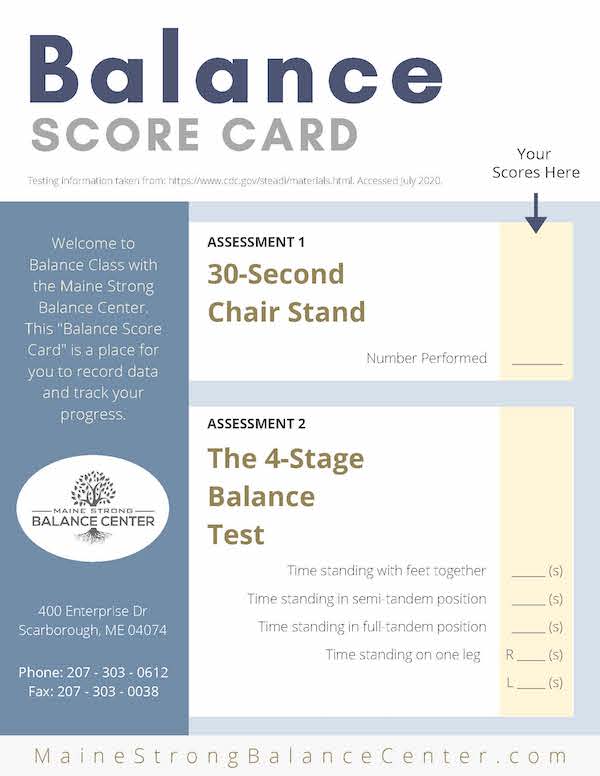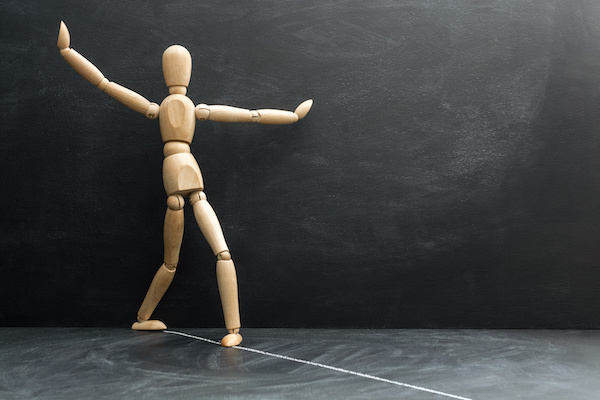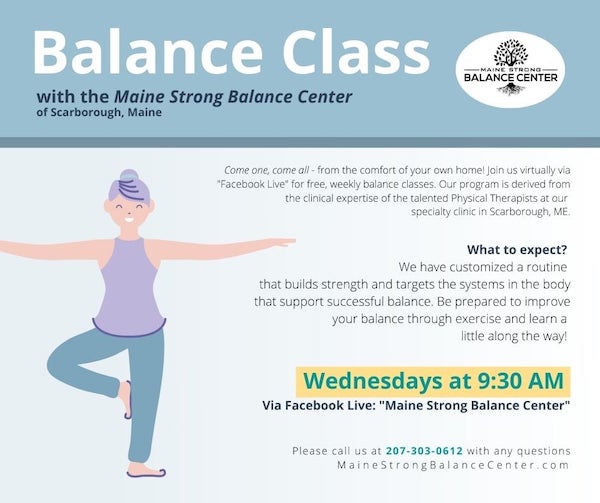Why is it that sometimes I feel a little off-kilter lately? Find myself leaning this way or that? I’m apt to mutter that if I don’t pay better attention, I’m surely going to fall and break something. The dreaded broken hip. Is it just an inevitable consequence of getting older? If it does have to do with aging, are there things we all can do to improve our balance?
I recently attended an online balance class offered by Thomas Memorial Library in Cape Elizabeth, Maine. If you haven’t already, do yourself a favor and check out their website. They have a multitude of wonderful online programs for people of all ages. The beauty of online is that you don’t have to live in Maine to take advantage.
The balance class was taught by Jason Adour, a physical therapist who owns Maine Strong Balance Center. He’s a great guy and knows what he’s talking about. I’ve done several blog posts with him, including this one about back pain, featuring his mother-in-law, who decided to build herself a new patio out of paving bricks and paid a price.
Jason began the five-week class by explaining the different causes of balance issues. Age is a contributor but falling is not a normal part of aging. Most falls can be prevented. Here are a few things to be mindful of (including looking where you are going).
- You need regular exercise — aerobic, strengthening, and balance.
- You need to get your eyes checked to make sure your vision is ok.
- You need to check your environment to make sure it’s free from any hazards.
- You need to have a conversation with your doctor about medications you may be taking, medical conditions that could affect your balance, concerns about previous falls, or whether you ever feel dizzy, have pain, are short of breath, or have numbness, tingling, or pins and needles in your feet.
It also helps to have an understanding of how the balance systems in our bodies work. There are three of them and they all play an important role in keeping us from toppling over.
The Somatosensory System
The somatosensory system is part of the sensory nervous system. When something touches our skin, receptor cells send signals to the brain. It could be a light or a firm touch, it could be a steady pressure or a vibration. Along with these signals from the skin, receptor cells in your muscle, bones, tendons, and joints also give the brain valuable information about your body’s position in space. For example, if you are leaning forward, there will be more pressure on the balls of your feet. If there is something wrong with this system, it increases your risk of falls 2.4 times.
The Visual System
Sight is vitally important to balance because it helps us see where we are going and to orient ourselves. We need to see well in all kinds of situations and from different directions.
The Vestibular System
This system is also known as the inner ear and is crucial because it coordinates movement and balance. The way the system works is it detects motion, your head position, and spatial orientation (where your body is in the space it occupies) and sends the information to your brain. The brain uses that information to tell your muscles and eyes what they need to do to keep you balanced.
When something is wrong with your vestibular system, you can not only lose your balance, but you may also experience vertigo (feels like you’re spinning), and feel nauseous.
I’ve tried to keep the explanations simple, but, in truth, maintaining our balance is a complex, coordinated effort.
So … is there anything you can do to improve your balance if you’ve also been feeling a bit wobbly lately? Yes, says Jason. But first, a little test to see if you really do have a problem and to track your progress if you start an exercise program (which Jason recommends).

Assessment 1 — 30-second chair stand
Tests leg strength and endurance
- Sit in the middle of the chair.
- Place each hand on the opposite shoulder crossed at the wrists.
- Keep your feet flat on the floor.
- Keep your back straight and your arms against your chest.
- On “go,” rise to a full standing position, then sit back down again.
- Repeat this for 30 seconds.
Below Average Scores (means you have a problem)
| AGE RANGE | MEN | WOMEN |
| 60-64 | <14 | <12 |
| 65-69 | <12 | <11 |
| 70-74 | <12 | <10 |
| 75-79 | <11 | <10 |
| 80-84 | <10 | <9 |
| 85-89 | <8 | <8 |
| 90-94 | <7 | <4 |
Assessment 2 — The four-stage balance test
The goal here is to see if you can stand for 10 seconds in each of the positions below. If you can hold the first position for 10 seconds without moving or needing support, go to the next. If you can’t, stop.
- Feet together
- Semi-tandem position — you want the instep of one foot touching the big toe of the other foot.
- Tandem position — one foot in front of the other, with toe touching heel.
- Stand on one foot.
If you can’t hold the first three positions, particularly the tandem position, for 10 seconds, you are at an increased risk of falling and should consider seeing a physical therapist or attending an evidence-based falls class.
Strategies to improve your balance
Here are some strategies you can consider if you did pretty good on the test, but realize you could do even better.
Chair rise exercise
If your legs are weak it increases your risk of falling. Try this exercise to get stronger.
- Sit in a chair and move to a standing position
- Start out using your hands to help you up
- Try doing it without using your hands
- Repeat as many times as you can three times a week
In this blog post and video, Kathleen Morlock from Maine Strong Balance Center demonstrates how to get out a chair: Here, let me help you out of that chair.
Balance exercise
Practice makes for better balance.
Pick a position from the 4-stage balance test — one that is challenging, but you can hold safely. Try holding it for 60 seconds. Do this one to three times every day.
Calf stretch
Flexible calves are important for walking and may help prevent you from catching your toe or tripping.
- Press your hands against the wall or put them on a countertop.
- Bend one knee slightly and stretch the other leg behind you.
- Do this three times with the right foot back and three times with the left foot back.
- Hold for 30 seconds on each side.
- Try to do this every day.
You can also add additional challenges for extra measure, says Jason.
Essential to balance training is dosage and intensity, very similar to strength training. In order to change balance systems, they need to be provoked and challenged. So, adding challenges is akin to adding intensity, or weight, to a strengthening exercise.
Additionally, everyone’s balance profile is different and would benefit from certain specific challenges as a result. For example, for some folks, the inner ear (vestibular system) is the main source of their imbalance. For these folks, closing your eyes puts increased pressure on that system which can be advantageous for rehabilitation!
Another example is when we evaluate folks, we sometimes identify that someone has difficulty doing two things at once, for example walking with a full beverage in their hand. This is called dual-task = two things at once. If this is difficult for someone, we utilize dual-task training, which can include a cognitive task (counting backward) or a physical task (holding something while balancing). The results are best when the program is customized. However, adding any balance exercises to your fitness program generally is an important first step!
Jason Adour, Physical Therapist and founder/owner of Maine Strong Balance Center
The important thing for us to remember, says Jason, is that “good balance is foundational to good health.” One in four people over 65 and one in two over 80 will fall each year. I do not like those odds.
When you have a problem with balance it can stop you from doing the things you love, not to mention the myriad daily tasks and movements we often take for granted. Walking from here to there, going up and downstairs, going to the bathroom, climbing into the tub, going for a walk, dancing, scooping up your grandchildren. Oh, my, the list goes on and on.
If you’re having trouble, it might be worth checking in with your doctor to make sure there’s nothing medical going on or that a medication you’re taking isn’t the cause. And if it turns out that what you need is some regular exercise or some balance tips, heed Jason’s advice and start doing something positive for yourself.
Difficulty with balance need not necessarily be a “normal” part of aging. We have tools, in the form of balance exercise, to do something positive — similar, again, to our ability to use strengthening or cardiovascular exercise.
The research on balance and the results we see here at the Balance Center are clear that when starting a balance exercise program you can expect a 25-40% improvement in your balance as measured by a battery of objective physical therapy tests similar to the Balance Score Card tests.
This improvement can be achieved over approximately 50 hours of training. The training can be spread out over a period of time up to a year, so even spending 10 minutes a day would achieve the necessary dosage. The training intensity must be at least moderate, meaning it’s a challenge for you.
My sincere hope is that we can all add in some balance exercise to our existing exercise programs and enjoy the benefits of better balance! And as always, if you need a little individual guidance, contact a physical therapist who is experienced in improving balance to help guide you.
Jason Adour
Balance class
Maine Strong Balance Center offers a weekly balance class that has been virtual since the onset of COVID-19. It’s live streamed on Facebook every Wednesday from 9:30 to 10:30.
You’ll find an archive of previous classes on their YouTube page in case you can’t do the live classes.



Enjoyed reading the article. Another one that is really tough is to stand, cross your legs so the outside of your feet are touching each other. From that standing position, sit on the floor without using your arms and hands, and then stand back up from the sitting position without using your arms and hands. I read a short article that said if you can do this it most likely means you will live a long time. I’m 73 and can still do it.
Send me a video and I will post it!